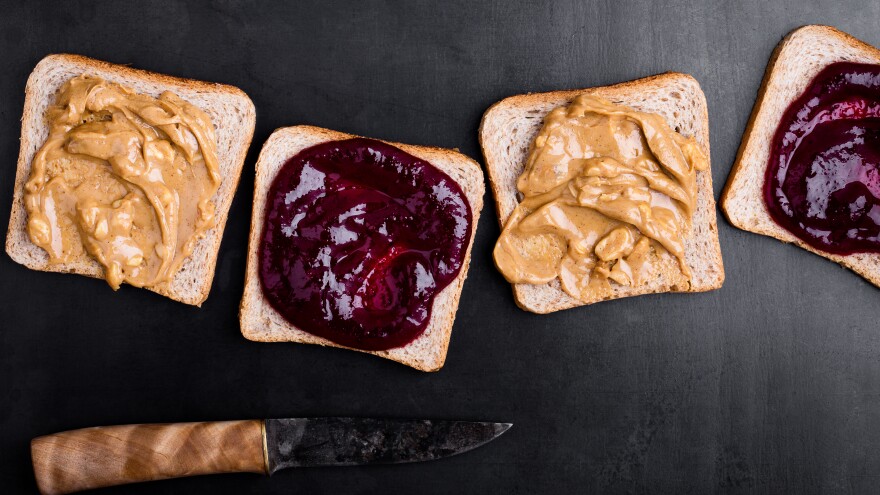Updated October 12, 2021 at 4:41 PM ET
Sunday's NFL game was served with a side of peanut butter and jelly.
Controversy over the ratio of peanut butter to jelly sparked when thunderstorms interrupted the Buffalo Bills vs. Kansas City Chiefs matchup, as NBC Sports' Michele Tafoya reported during a game delay.
"They are eating sandwiches — although a couple have complained to me that there's too much peanut butter on the sandwiches," Tafoya said. "It's like 70-30 with the jelly, so they're not enjoying those as much."
A conversation then spilled online as commentators, fans and players waited for the second half of the game to start. Twitter users shared their own formulas to make the perfect sandwich and considered the 70-30 ratio an "abomination." Some shared that their preference was no ratio at all. They simply want an all-peanut butter or all-jelly sandwich.
Debates about the best cutting method (triangular or rectangular), bread types (white, whole wheat or sourdough) and levels of peanut butter crunchiness ensued.
70/30 on the peanut butter to jelly ratio. Damn! @SNFonNBC #BillsMafia Mrs.Tafoya with the kind of sideline reporting we need. #BUFvsKC @miketirico @TonyDungy @drewbrees Gotta go Strawberry with the diagonal cut. I’m a 60/40 guy.
— DoctorRobert333 (@4million4peace) October 11, 2021
Grape jelly will always be the standard, but strawberry is permissible. Apricot and other variants are needlessly deviant and reflect an absence of stability.
— Charlotte Clymer 🏳️🌈 (@cmclymer) October 11, 2021
Crunchy peanut butter is chaotic. Fancy pb is too fussy. Smooth, generic pb is the standard.
On the perfect ratio, Morning Edition consulted an expert: Kevin Pang from the PBS TV show "America's Test Kitchen" suggests that a 5-to-4 is the optimum ratio of peanut butter to jelly.
"You really don't need too much of the jelly for it to poke through," Pang said.
The combination of a gooey jam and a savory peanut butter between two slices of bread is a uniquely American sandwich. According to the National Peanut Board, the first PB&J recipe appeared in 1901 in the Boston Cooking School Magazine of Culinary Science and Domestic Economics. The author, Julia David Chandler, suggested not strawberry or grape but currant or crab-apple jelly.
Other cultures have their own version of the sandwich, Pang said. In Australia, for example, a dish called "fairy bread" also has three ingredients: white bread, butter and sprinkles.
"You can do chocolate sprinkles, you can do cake sprinkles," Pang said. "You can argue that might be the PB&J of Australia."
In Singapore, their version is kaya toast. It's made with bread, butter and kaya jam, also known as coconut jam. A recipe in Iraq uses date syrup and tahini on bread.
I am very sorry I missed all the PB&J discourse during last night's weather delay! There should always be more peanut butter than jelly - a 70/30 ratio #BUFvsKC
— Buffalo Jen (@BooksandBills) October 11, 2021
Though the game resumed and ended with a Bills win over the Chiefs, the sandwich discourse has raged on. And suffice to say that almost no one prefers nuclear secrets in their PB&J.
Tien Le is an intern on NPR's News Desk.
Barry Gordemer and Phil Harrell produced and edited the audio story.
Copyright 2023 NPR. To see more, visit https://www.npr.org.





